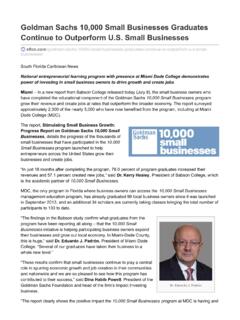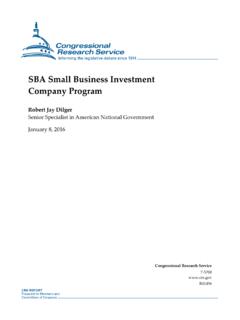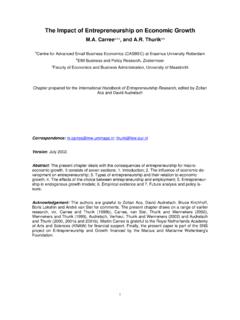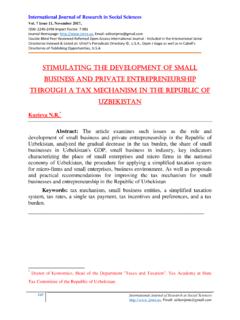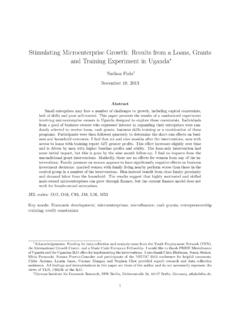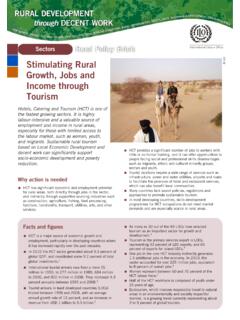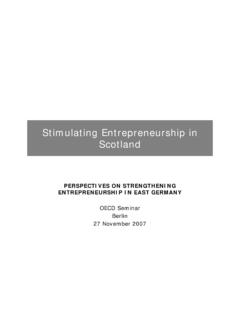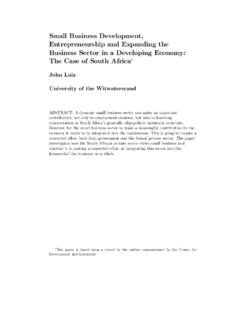Transcription of Stimulating Investment in Emerging-Market SMEs
1 Volume8 October 2009 Financial Innovations Lab ReportFinancial innovations lab RepoRtStimulating Investment in Emerging-Market SMEsThis Financial Innovations Lab Report was prepared by Jill Scherer, Betsy Zeidman, and Glenn Innovations Labs bring together researchers, policy makers, and business, financial, and professional practitioners for a series of meetings to create market -based solutions to business and public policy challenges. Using real and simulated case studies, Lab participants consider and design alternative capital structures and then apply appropriate financial technologies to lu m e8 Stimulating Investment in Emerging-Market SMEsFinancial innovations lab RepoRtOctober 2009 Financial Innovations Lab ReportWe are grateful to those who participated in the Financial Innovations Lab and the panelists of our Global Conference roundtable on this topic for their contributions to the ideas and recommendations summarized in this report.
2 We especially thank Sonal Shah, Kim Thompson, and John Lyman of as well as Tom Gibson of the Institute for SME Finance for their valuable input into developing the Lab. We are grateful for John s continued support throughout the Lab planning process. We also thank Tom for researching and writing the case studies that were critical to the Lab s success. Finally, we wish to express our appreciation to Milken Institute Financial Innovations Lab coordinator Caitlin MacLean, executive assistant Karen Giles, and editors Lisa Renaud and Melissa Bauman for their tremendous effort, along with all our Institute colleagues for their c k n o w l ed g m en t sThe Milken Institute is an independent economic think tank whose mission is to improve the lives and economic conditions of diverse populations in the United States and around the world by helping business and public policy leaders identify and implement innovative ideas for creating broad-based prosperity.
3 We put research to work with the goal of revitalizing regions and finding new ways to generate capital for people with original focus on: human capital: the talent, knowledge, and experience of people, and their value to organizations, economies, and society; financial capital: innovations that allocate financial resources efficiently, especially to those who ordinarily would not have access to them, but who can best use them to build companies, create jobs, accelerate life-saving medical research, and solve long-standing social and economic problems; and social capital: the bonds of society that underlie economic advancement, including schools, health care, cultural institutions, and government creating ways to spread the benefits of human, financial, and social capital to as many people as possible by democratizing capital we hope to contribute to prosperity and freedom in all corners of the are nonprofit, nonpartisan, and publicly supported.
4 2009 Milken InstituteIntroduction ..5 Part I: Issues & Perspective ..7 Funding Challenges The Financial Innovations LabPart II: Financial Innovations For StimulatingInvestment in Emerging-Market SMEs ..19 Barrier: Exiting Investments Is Difficult. Solution 1: Create an Exit Finance Facility Solution 2: Create a Permanent Capital Vehicle Solution 3: Use the Royalty Model Barrier: SME Investment Returns Are Not Fully Risk-Adjusted. Solution 4: Create Regional Funds or Funds of Funds Solution 5: Use Technical Assistance Funds Side-By-Side with Investment Funds Solution 6: Use Structured Finance to Broaden the Investor Base Solution 7: Guarantee Funds from Local Banks Barrier: Information Gaps Exist Between Investors and SMEs Solution 8: Create Mechanisms to Match Investors and Entrepreneurs Solution 9: Collect Aggregate-Level Data on SMEsConclusion.
5 29 Appendix I: Financial Innovations Lab Participants ..30 Appendix II: Panelists in Global Conference Roundtable ..31 Appendix III: Literature Review ..32 Endnotes ..39Ta bl e of C on t en t s4 Financial Innovations LabRisk capital patient, non-asset-based capital that facilitates the growth of new and expanding companies is scarce for SMEs in the developing many large institutions have begun to stabilize and recover from the global financial crisis, a serious credit crunch continues. small - and medium-sized enterprises (SMEs) face particular challenges to survival and growth . Even in good economic times, these firms lack access to flexible capital, constraining their ability to expand.
6 The current environment exacerbates this difficulty, leading to a dangerous trend because it affects the broader February 2009, the Milken Institute held a Financial Innovations Lab in New York City to explore ways to increase the availability of risk capital to SMEs in developing countries. Risk capital that is, patient, non-asset-based capital that facilitates the growth of new and expanding companies is scarce for SMEs in the developing world. This lack of flexible capital is due in large part to the illiquidity of these markets. With few apparent exit opportunities, investors are reluctant to risk investing their money in Emerging-Market SMEs. Capital access is particularly difficult for smaller companies requiring Investment in the range of $100,000 to $ million.
7 Because SMEs are critical engines of job creation and economic growth , it is important to increase the availability of risk capital to these Lab brought together fund managers, investors, entrepreneurs, researchers, and representatives from development finance institutions and foundations to identify obstacles hindering Emerging-Market SMEs access to capital and to explore potential solutions. Lab participants examined case studies of successful SME investments, reviewed presentations, and exchanged ideas through moderated discussions. Follow-up conversations among participants continued in the weeks after the Lab, and a roundtable session took place at the Milken Institute Global Conference in April 2009.
8 These discussions provided the opportunity to flesh out some of the solutions identified in the Lab, and these additional ideas were integrated into this report where t r od u c t i on6 Financial Innovations LabLarge firms have access to bank lending and other financing sources, while individuals and very small businesses can obtain funds from microfinance Fewer resources exist for small ChallengesIn developed countries, SMEs are widely recognized as key contributors to employment, innovation, productivity, and economic growth . They account for 57 percent of total employment and just over half of gross domestic product (GDP).1 In the United States, they have accounted for 60 percent to 80 percent of net new employment since the mid-1990s.
9 Very small firms tend to generate job gains more quickly than larger firms after a recession. 2 In developing countries, growth is far more constrained. Among low-income countries, SMEs contribute just 18 percent of employment and 16 percent of If barriers to their growth were removed, SMEs would contribute more to economic development by providing jobs and income, expanding the middle class, broadening the tax base, and ultimately decreasing poverty levels. Access to flexible capital is among the most significant barriers for Emerging-Market SMEs (see figure 1). Although securing financing is a challenge for all types of firms in poorer nations, small and medium-sized firms experience greater difficulty accessing capital than large ones, with small firms having the most difficulty.
10 Indeed, Beck, Demirg -Kunt, and Maksimovic (2005) find that SMEs face greater financial, legal, and corruption obstacles than large firms, and these challenges constrain the growth of SMEs to a greater Financing is challenging to secure in emerging markets for several reasons. External sources of financing are difficult to access, and few venture capital and private equity investors operate in developing markets. In addition, many investors put their money elsewhere due to the illiquidity of these banks, meanwhile, tend to be conservative in their lending practices, generally allocating capital to more established companies. Providing retail services and short-term credit to the SME sector represents a lucrative business segment for banks, but start-up and expansion capital remains virtually inaccessible.
